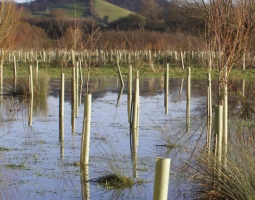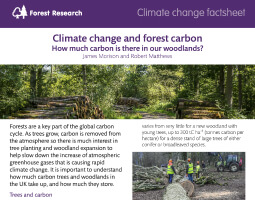Temperature Projections
Understanding the changing temperature pattern is crucial for making informed decisions about forest management and conservation. Temperature changes will substantially impact forest ecosystems, influencing tree, vegetation, microbe and animal growth rates and reproduction, the distribution of species, and overall forest health and functioning.
Temperature projections provide insights into how future temperatures may change, helping us anticipate potential challenges, benefits and plan for the future climate. This page provides temperature projections up to 2080 for the UK.
Projected change in annual average temperature (°C) over the UK from 2000 to 2080 across 4 distinct periods for the RCP 8.5 scenario – Forest Research, 2025
How is temperature likely to change in the UK?
This temperature video illustrates the average annual surface air temperature (°C) across four distinct 20-year time periods. The data indicates a continuing warming trend across the UK, with projections suggesting that by 2080, annual temperatures could increase by 2.4 °C to 4.8 °C compared to the 1980-2000 baseline under the RCP8.5 scenario.
This warming trend is likely to accelerate, and the rates at which the warming increases is anticipated to be more pronounced during the summer months than in winter. Additionally, there is an identifiable geographical difference in temperature increases, with the southern regions of the UK projected to experience greater warming compared to northern Scotland.
Due to the proximity of the Shetland Isles to the northern boundary of the model domain used for these projections, data produced here are not reliable and should not be used.
What risks does temperature changes pose to forests?
The UK’s typically mild climate and variable weather patterns mean that rising temperatures can have substantial consequences for forests and woodlands and affect various ecological processes (Climate change in the UK – Met Office).
Warmer summers often lead to more frequent and intense heatwaves, extending the duration and severity of drought conditions. This increased heat and prolonged dryness stress trees and other vegetation due to water scarcity, ultimately reducing their growth. Additionally, warmer spring temperatures can initiate earlier bud bursts, making trees more vulnerable to late frosts, which can damage new growth and reduce overall tree vigour. Accelerated pest and disease cycles, driven by these warmer conditions, lead to more frequent and severe infestations, further weakening trees and making forests more susceptible to other stresses. While extended growing seasons can enhance tree growth and increase forest productivity, these benefits may be countered by increased wildfire risk and the spread of invasive species.
Temperature changes can also have a much more wide-ranging impact on forest health and productivity. Earlier leaf flushing and flowering times in warmer temperatures may reduce pollination success, and with delayed leaf fall may disrupt the timing of food availability for wildlife, alter nutrient cycling and water usage, which may affect the overall productivity, stability and resilience of forest and woodland ecosystems.
Overall, these changes pose significant challenges to forest health and resilience. Careful management and adaptive strategies are essential to mitigate the impacts and ensure resilience against future climate variability.




